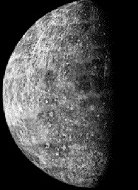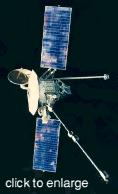
 |
Mercury - closest to the Sun |
|
| |

Vital StatsMercury is the closest planet to the Sun. Its orbit is said to be "inferior", as it lies between the Sun and the Earth. Consequently, it always appears in the sky near to the Sun, being visible a little before sunrise or a little after sunset. It takes 87·9 days to complete its orbit. Blown AwayThe planet has no appreciable atmosphere, although a small amount of hydrogen, helium and other elements are surprisingly present. The temperature on the Sun-facing side is as high as 430°C. The planet rotates once every 58·6 Earth days, so its entire surface sees the Sun as a result. This surface is well cratered, and has some mountains and valleys. Interestingly, its rotation is tidally coupled to the Sun, rotating 1·5 times every orbit. Frozen Poles!Perhaps more unexpected than its ultra-thin atmosphere (perhaps provided by passing comets?), is that Mercury has ice caps. These can exist because they are in permanent shadow due to the low position of the Sun on the horizon and mountainous terrain. Mercury is the densest of all the planets, with a large iron core. This also gives it an appreciable magnetic field. Sole Visitor Much of the detailed information on Mercury was found by the NASA 1973 - 1975 Mariner 10 mission launched from Cape Canaveral. To date this has been the only probe to visit the planet, flying by on three occasions. Much of the detailed information on Mercury was found by the NASA 1973 - 1975 Mariner 10 mission launched from Cape Canaveral. To date this has been the only probe to visit the planet, flying by on three occasions.
|
A book on transits of Venus and Mercury is available here. Future Messenger
This raises the question: why take so long getting there? In order to enter a permanent orbit, it needs to approach Mercury at slow speed, or it must carry enough fuel to slow down. The latter is impossible - tonnes of fuel could not be carried, let alone launched from Earth. Instead, the probe will use the gravity of Earth, Venus and Mercury to orientate itself appropriately to allow a smooth orbital insertion around the planet. Mercury Re-visitedThe probe (shown above right) will flyby Mercury in January and October 2008, giving humans the first close-up images of the planet for more than 30 years. Amazingly, it will be the first time that we will have viewed the entire surface in this way - Mariner 10 only saw one half. The probe has a large collection of science instruments. They are designed to help answer the following questions:
| ||||
|
Sun | Mercury | Venus | Earth | Moon | Mars | Asteroids | Jupiter | Saturn | Uranus | Neptune | Pluto | X | Kuiper | |||||